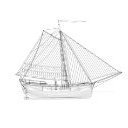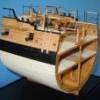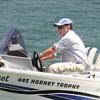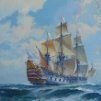-
Posts
596 -
Joined
-
Last visited
Reputation Activity
-
 Dziadeczek got a reaction from Mark P in Focus Stacking
Dziadeczek got a reaction from Mark P in Focus Stacking
This was my very first attempt at focus stacking, using my old Nikon d200, standard kit zoom lens 18-70, a tripod, no rails. Merging on Photoshop.
I am quite satisfied with the result. What do you think, guys?
Thomas
-
 Dziadeczek reacted to AiDi in Hello from Poland :)
Dziadeczek reacted to AiDi in Hello from Poland :)
Hi everyone! My name is Adam and I'm from Warsaw, Poland.
Ship modelling was my big fascination when I was a teenager but I didn't do much with that because there were no hobby shops in my town and I had no internet at that time. Besides, wood modelling is kind of expensive and we didn't have that much money. The biggest thing I did, well at least started to do, was a model of Titanic from Hachette collection. Unfortunately I didn't finish it - when my mom saw that it will have 100 issues she said "honey, nope". Nevertheless I liked the idea of model making. Some time later I saw in one of our press shops an issue of polish modelling magazine which discussed a type of ships that I fell in love with instantly – galleons. Oh Lorde. The thing that brought my attention the most was rigging. I also liked over the top ornamentations, and castle-like structre – a lot of decks that were placed high in the aft. But rigging – how in the hell that worked? What it consisted of? So many questions, no way to answer.
In the meantime we got internet, so I started reading as much as possible. I liked drawing projects of galleon models (and also shipyard cranes, what a weird passion 🙃), but that is that, I never got the chance to do a proper model. Time flied by, and I put the whole idea to rest.
Until 2019, when I saw an advert of new DeAgostini collection - Soleil Royal. The passion came alive again, but with new possibilities! Internet, books, money 😁 Of course, silly me, I wanted to bash the kit and do a lot of enhancements. But the problem was, and still kind of is, that this model has a lot of design flaws, which caused my enthusiasm to die for a while. It got back to life as soon as I had an idea what to do with this model, which was not that long ago, but more on this in a separate topic.
In the meantime I bought and started assembling Montanes by OcCre. Yeah, I know. Big and difficult set for the beginner, a straight route to a disaster. But I guess I did pretty well with what I did. I stopped at hull planking since I felt I needed to gain some experience on something simpler. Montanes has only one layer of planking so there's no room for learning - you have to know what you're doing. I'll get back to it some day, when Soleil is finished.
Rigging is still my biggest fascination. I'm reading about it as much as possible. Anderson, Lees, Pettersson. Also I love book by Wolfram zu Mondfeld. During the time I was reading books, forums and other sources I realized that 16th and 17th century galleons are my main interest and probably I will focus only on them (maybe HMS Victory will be an exception). Some day I want to start scratch building, but until that, I'll gain my experience working with kits. Also, and that may be a little bit controversial - I am not that much focused on, and devoted to, historical accuracy. I mean, I was reading topic on Royal Katherine by Doris, and she didn't do some things in the cabins because English ships didn't have that at that time, but Dutch did. If it was me I would go for the Dutch looks, more than for English historical accuracy. Maybe it's more accurate to say that at the moment I'm building a model that resembles Soleil Royal, more than recreates it in the most accurate way. E.g. I plan on implementing La Couronne rigging to it, even though I know it's an anachronism. But hey, that's my way of doing it, you don't have to like it 🙂
Besides modelling - I am 30 years old, I have masters in theoretical physics and my interests focus around the geometrical foundations of quantum and classical field theories. I work as a private teacher.
-
 Dziadeczek reacted to Vegaskip in Ship paintings
Dziadeczek reacted to Vegaskip in Ship paintings
Done yesterday and this afternoon , based on HMCS Montreal and HMCS Skeena 16.5” X 11.75”
-
 Dziadeczek got a reaction from Dave_E in Planking Question
Dziadeczek got a reaction from Dave_E in Planking Question
Also you can plank your hull with full length planks and afterwards score each plank across with a sharp exacto blade to imitate the joints between individual planks. I think this way might be a bit easier rather than trying to shape each shorter plank individually and identically to the rest of the short ones.
-
 Dziadeczek got a reaction from Archi in American Ship Models * And How to Build Them
Dziadeczek got a reaction from Archi in American Ship Models * And How to Build Them
Over a period of ~ 25 years, I visited this museum probably about a dozen of times, or so. And each time I took a handful of photographs. So, today I have quite a collection of pics from there.
It is not nearly as big as, let's say, The US Navy Museum in Annapolis, but It is a very interesting little maritime museum, with an exceptionally friendly staff, mostly of volunteers, passionate individuals, who fondly greet every visitor and are willing to help him/her.
This is the museum, the next NRG conference will be held next year.
Their collection of ship models includes, among the others, about half a dozen ship models by the late Edward Marple, who was a dental technician, so he was quite handy with his dental drill and was using it quite skillfully for carving the ornamentation for his models. Among those especially interesting ones, are his Sovereign of the Seas, the Royal George and the Royal Katherine...
The museum also has quite an interesting collection of maritime paintings, among them a large format painting of the Royal Sovereign by Van de Velde the Younger. I also like very much their paintings by John Stobart.
Here is a handful of my pics from my last visit in June 2019. (Hopefully I will be able to attend the upcoming Conference and revisit their models again).
Sovereign of the Seas by Edward Marple
Sovereign of the Seas by Edward Marple
Sovereign of the Seas by Edward Marple
Sovereign of the Seas by Edward Marple
Vasa by William Siegfried
Xebec L'Indiscret by Unknown
galley La Reale de France
Frigate Seahorse by James Cutler
Royal George by Edward Marple
Royal George by Edward Marple
Royal Katherine by Edward Marple
John Bentham Dinsdale "English King Charles II receiving the fleet after the Battle of Solebay 1672"
prisoner of war bone model
Royal Katherine by Edward Marple
Mars
HMS Serapis
Charles Martin Powell "British Man-O- War with Dutch Sailing Vessels in a Choppy Sea" 1805
Chinese Exhibit
Steam Yacht "Mayflower"
Steam Yacht "Mayflower"
John Stobart "Vallejo Street Wharf, San Francisco 1863"
Montague Dawson "The Atlantic sailing packet Daniel Webster"
Jonn Stobart "Clipper Ship 'Nightingale' Towing Out Past Greenwich in 1852"
John Stobart "Nantucket Sunrise"
Edward Marple's workplace (museum reconstruction)
E. Marple's workplace
E. Marple's workplace
E. Marple's workplace
HMS "Prince" Edward Marple's last model (unfinished)
E. Marple's workplace with unfinished HMS "Prince"
E. Marple's workplace & unfinished HMS 'Prince'
E. Marple's workplace - detail
Roy Cross "Robert E. Lee in New Orleans 1870s"
Roy Cross "Steamer Adelaide Passing Fort McHenry"
Roy Cross "The Devonshire"
John Wilson Carmichel "Squadron of Frigates and Fishing Vessels in a Choppy See off Holy Island"
And the last pic here is a general view of Mr. Marple's workshop (reconstructed) again
-
 Dziadeczek reacted to archjofo in La Créole 1827 by archjofo - Scale 1/48 - French corvette
Dziadeczek reacted to archjofo in La Créole 1827 by archjofo - Scale 1/48 - French corvette
Hello,
I am very happy about the extremely nice comments from all of you and the many LIKES.
That of course motivates me a lot and gives me the feeling of being part of a really great community that pursues the same interests. Thanks again for that.
Continuation: Mizzen topgallant stay - Étai mât de perruche
As already reported on this topic some time ago (LINK), the monograph by J. Boudriot does not reveal in detail how the mizzen topgallant stay was attached. In this respect, I orientated myself on examples from relevant literature.
Before attaching the stay (model rope ø 0.46 mm), its length must be determined on the model, as it is guided over a single block (length 4 mm) and integrating the thimble on the model is not necessarily recommended.
The next picture shows the finished mizzen topgallant stay and the two-legged sling (counterpart for the lanyard lashing), which is attached to the trestle trees.
The lanyard for the lashing to fix the mizzen topgallant stay was set up with a simplified splice or fake splice (unfortunately I don't know the English name).
In the last picture you can see the finished lanyard lashing. A corresponding enlargement in the cut-out at the top left.
Sequel follows …
-
 Dziadeczek got a reaction from albert in HMS Naiad 1797 by albert - FINISHED - 1/48
Dziadeczek got a reaction from albert in HMS Naiad 1797 by albert - FINISHED - 1/48
Could I please. trouble you for a close up photo of your figurehead? What is it made of?
Regards,
Thomas
-
 Dziadeczek got a reaction from EricWilliamMarshall in Le Rochefort by No Idea - 1/24th Scale - First POF Build
Dziadeczek got a reaction from EricWilliamMarshall in Le Rochefort by No Idea - 1/24th Scale - First POF Build
I wouldn't worry too much about the filling pieces now. Make all hawse frames first and make sure they all fit and that their external surfaces are smooth (inner surfaces will later be smoothed). And only then try to make those fillers, carefully sanding down their thicknesses to fit to the available spaces in between the hawse frames.
I too had a hard time making them for my "Frenchie" (of course, later on I bought the addendum brochure from Ancre with all profiles of the missing frames, including the hawse timbers, but it was already after I managed to shape them all by myself from the waterlines). Tough luck...
-
 Dziadeczek reacted to Vegaskip in Ship paintings
Dziadeczek reacted to Vegaskip in Ship paintings
Thank you all for commenting . Haven’t been doin much lately. Did this book cover for a friend. The original was taken to Canada by RCN Minesweeper along with a rare Corvette's skiff , discovered in the boat shed in Portsmouth Dock yard
-
 Dziadeczek got a reaction from tlevine in Le Rochefort by No Idea - 1/24th Scale - First POF Build
Dziadeczek got a reaction from tlevine in Le Rochefort by No Idea - 1/24th Scale - First POF Build
I wouldn't worry too much about the filling pieces now. Make all hawse frames first and make sure they all fit and that their external surfaces are smooth (inner surfaces will later be smoothed). And only then try to make those fillers, carefully sanding down their thicknesses to fit to the available spaces in between the hawse frames.
I too had a hard time making them for my "Frenchie" (of course, later on I bought the addendum brochure from Ancre with all profiles of the missing frames, including the hawse timbers, but it was already after I managed to shape them all by myself from the waterlines). Tough luck...
-
 Dziadeczek got a reaction from No Idea in Le Rochefort by No Idea - 1/24th Scale - First POF Build
Dziadeczek got a reaction from No Idea in Le Rochefort by No Idea - 1/24th Scale - First POF Build
I wouldn't worry too much about the filling pieces now. Make all hawse frames first and make sure they all fit and that their external surfaces are smooth (inner surfaces will later be smoothed). And only then try to make those fillers, carefully sanding down their thicknesses to fit to the available spaces in between the hawse frames.
I too had a hard time making them for my "Frenchie" (of course, later on I bought the addendum brochure from Ancre with all profiles of the missing frames, including the hawse timbers, but it was already after I managed to shape them all by myself from the waterlines). Tough luck...
-
 Dziadeczek got a reaction from dvm27 in Le Rochefort by No Idea - 1/24th Scale - First POF Build
Dziadeczek got a reaction from dvm27 in Le Rochefort by No Idea - 1/24th Scale - First POF Build
I wouldn't worry too much about the filling pieces now. Make all hawse frames first and make sure they all fit and that their external surfaces are smooth (inner surfaces will later be smoothed). And only then try to make those fillers, carefully sanding down their thicknesses to fit to the available spaces in between the hawse frames.
I too had a hard time making them for my "Frenchie" (of course, later on I bought the addendum brochure from Ancre with all profiles of the missing frames, including the hawse timbers, but it was already after I managed to shape them all by myself from the waterlines). Tough luck...
-
 Dziadeczek got a reaction from mtaylor in Le Rochefort by No Idea - 1/24th Scale - First POF Build
Dziadeczek got a reaction from mtaylor in Le Rochefort by No Idea - 1/24th Scale - First POF Build
I wouldn't worry too much about the filling pieces now. Make all hawse frames first and make sure they all fit and that their external surfaces are smooth (inner surfaces will later be smoothed). And only then try to make those fillers, carefully sanding down their thicknesses to fit to the available spaces in between the hawse frames.
I too had a hard time making them for my "Frenchie" (of course, later on I bought the addendum brochure from Ancre with all profiles of the missing frames, including the hawse timbers, but it was already after I managed to shape them all by myself from the waterlines). Tough luck...
-
 Dziadeczek reacted to toms10 in HMS Leopard by toms10 - FINISHED - 1:85 scale POF/POB
Dziadeczek reacted to toms10 in HMS Leopard by toms10 - FINISHED - 1:85 scale POF/POB
Hi everyone
I finally was able to finish the display case. Right now it is just sitting on an old table in my modeling room. We are about to start refurnishing some of the rooms in our house i.e. rugs, couches, bedrooms and what ever else pops up. These projects tend to morph into much more than you originally plan. 🤔Once everything is back in order I can put the case in it’s final home. Here are some pics although the lighting was not to great. I plan on putting a couple of wireless light bars on the top glass plates to help with illumination.
Now I am going to attack a birthday present from 3 years ago, a 9000 piece puzzle of the battle at Algiers. I think it measures approximately 5ft by 7ft if I remember correctly. It will make a nice wall hanging in my modeling room.
Hopefully with a little help from my friends I can get the puzzle done by Christmas and then get started on a scratch build of the Charles W. Morgan.
Thanks again to everyone for the support during my Leopard build.
Tom
-
 Dziadeczek reacted to gjdale in 1869 Allerton Steam Pumper by gjdale - FINISHED - Model Trailways - Scale 1:12
Dziadeczek reacted to gjdale in 1869 Allerton Steam Pumper by gjdale - FINISHED - Model Trailways - Scale 1:12
A successful day at the “Fire Station” today, although not without it’s challenges.
The Brake System
The next step is the installation of the Brake System. Here are all the component parts:
We start by removing the wheels, propping up the main frame and front axle, and inserting the Brake Crossover Bar (second from left in the above picture) through the holes in the bottom of the Water Box. These were test fitted when the parts were being painted, so no unwelcome surprises here.
We then take connect the Brake U-link to the Brake Link using a pair of 0-80 nuts on the threaded end of the Brake Link. These will be used later on to adjust the length of the Brake Link.
The U-link is then connected to the Brake Crossover Bar on the right-hand side of the vehicle using a 0-80 x 1/4” bolt from the inside and securing with a 0-80 nut on the outside. Then we add the Crossover Bar Link on the left-hand side of the Crossover Bar and repeat the connection to the U-Link. Not particularly difficult, though something of a dexterity test.
We now need to install the Brake Lever Pivot Arms, Pivot Arm Braces, and the Brake Lever Arms. The Pivot Arms and Braces form a triangle that is bolted to the boiler wall using 00-90 bolts and nuts. They are positioned toward the bottom of the boiler. In this photo, you can see the length of reach required inside the boiler to be able to attach the nuts.
Here I decided to depart from the instructions and carefully inverted the entire model so that it sat on the boiler cap ring and was supported at the front end of the water box. This allowed me to access the bolts from the underneath of the boiler. I retained this position for the remainder of the installation. Here is the triangular bracing in place, along with the Brake Lever Arm.
Once both Brake Lever Arm assemblies had been attached, we are instructed to add the Brake U-connector to join both Brake Lever Arms to the Brake Link using 0-80 x 1/4" Bolts and Nuts. One problem with that…..the 1/4" bolts are not long enough for the job, as seen in this photo.
I had a dig through my leftover bits and pieces from my Pocher car build and found some suitable alternatives. They were slighter larger in diameter at 2mm, so I had to re-drill all the holes, which in turn meant dis-assembling some of what I’d already assembled. Here is the result:
While the bolts may now be a little too long, I’m not going to worry about cutting them shorter as they can’t be seen that well anyway. At this point, the misalignment issues discovered earlier came back to play and a little judicious bending of the brake arm assemblies was required.
The Main Drain was also inserted while the wheels were off. The pre-drilled hole in the boiler wall was a little too low for it to sit correctly, so I elongated the hole somewhat with a small needle file until I could get it to sit correctly.
The wheels were put on, at which point we find another error in the Bill of Parts. The wheels are held on with 1-72 nuts. The parts list indicates that 8 of these are supplied and indeed that is what was in the kit. Only problem is, 9 are required to build the model. By happy coincidence, the replacement nuts I used for the U-connector were just the right size to fit on the axle stub I had previously broken and re-glued. The remaining provided nuts all went on to the cast threads without issue.
Here is an overall shot of where we are at today:
-
 Dziadeczek got a reaction from mtaylor in HMS Naiad 1797 by albert - FINISHED - 1/48
Dziadeczek got a reaction from mtaylor in HMS Naiad 1797 by albert - FINISHED - 1/48
Could I please. trouble you for a close up photo of your figurehead? What is it made of?
Regards,
Thomas
-
 Dziadeczek got a reaction from hornet in Planking Question
Dziadeczek got a reaction from hornet in Planking Question
Also you can plank your hull with full length planks and afterwards score each plank across with a sharp exacto blade to imitate the joints between individual planks. I think this way might be a bit easier rather than trying to shape each shorter plank individually and identically to the rest of the short ones.
-
 Dziadeczek reacted to albert in HMS Naiad 1797 by albert - FINISHED - 1/48
Dziadeczek reacted to albert in HMS Naiad 1797 by albert - FINISHED - 1/48
Thank you very much for your comments and your liking, place the last photos, the model of Naiad is over, thank you so much for following me during construction and I thank Ed Tosti so much that with his magnificent drawings allowed me to build this beautiful frigate. Greetings to everyone and thanks again.
-
 Dziadeczek reacted to albert in HMS Naiad 1797 by albert - FINISHED - 1/48
Dziadeczek reacted to albert in HMS Naiad 1797 by albert - FINISHED - 1/48
Hi some photos of the base of the model under construction.
-
 Dziadeczek got a reaction from reklein in Frank J H Gardiner Painting
Dziadeczek got a reaction from reklein in Frank J H Gardiner Painting
I think it might be a gouache (a little thicker, less watery watercolor, applied a bit more opaque).
To make sure however, it is not a print, you might remove it (carefully!) from the frame and see if the paper has a slight indentation along the edges - if it does, that means that this indentation was caused by a graphic's press, and the artwork is/might be a print, like a lithography. But, in such instance, the artist would routinely write in pencil at the bottom margin the number of this particular issue, and the total number of the issues intended, as well as his/her name and the title of the artwork. Here we don't have any of this, at least I cannot see it.
So, probably it is a painting (very well executed!), either a watercolor, or more probably a gouache.
-
 Dziadeczek got a reaction from Dave_E in Rattlesnake by javajohn - Model Shipways - 1:64
Dziadeczek got a reaction from Dave_E in Rattlesnake by javajohn - Model Shipways - 1:64
Hi Javajohn ,
Since I built this model a long time ago, I don't remember now how long it took me to carve the transom. A few hours, at most. (I am a painfully slow modeler, I once knew a Japanese modeler, who would build three very intricate models in the time it took me to build one!)
Today I took a close up, macro pic of this transom. When I look at this pic, I think that it was rather a thin slice of boxwood I carved, instead of cherry - the color is more creamy/yellowish. The rest of the stern is cherry though.
I remember I made for this task a few tiny carving gouges, two from old discarded Dremel tips ground to the desired shape, and two or three from medical needles with their tips ground properly. You cannot buy such small gouges for this work anywhere, as far as I know!
Alltogether, this model is quite difficult and tricky to build, due to its small size. I remember they said that it was intended for an intermediate modeler, but I think that because of the size of tiny details and their delicate nature, it should be build by a more advanced modeler. One has to have a delicate touch and respect for the wood, plus very sharp tools...
PS: I just first noticed this glue blob oozing from the underneath of the lower left end of the transom; the pic is much larger than the model, so it exaggerates details and imperfections...
Happy modeling!
-
 Dziadeczek got a reaction from mtaylor in Frank J H Gardiner Painting
Dziadeczek got a reaction from mtaylor in Frank J H Gardiner Painting
I think it might be a gouache (a little thicker, less watery watercolor, applied a bit more opaque).
To make sure however, it is not a print, you might remove it (carefully!) from the frame and see if the paper has a slight indentation along the edges - if it does, that means that this indentation was caused by a graphic's press, and the artwork is/might be a print, like a lithography. But, in such instance, the artist would routinely write in pencil at the bottom margin the number of this particular issue, and the total number of the issues intended, as well as his/her name and the title of the artwork. Here we don't have any of this, at least I cannot see it.
So, probably it is a painting (very well executed!), either a watercolor, or more probably a gouache.
-
 Dziadeczek got a reaction from thibaultron in Frank J H Gardiner Painting
Dziadeczek got a reaction from thibaultron in Frank J H Gardiner Painting
I think it might be a gouache (a little thicker, less watery watercolor, applied a bit more opaque).
To make sure however, it is not a print, you might remove it (carefully!) from the frame and see if the paper has a slight indentation along the edges - if it does, that means that this indentation was caused by a graphic's press, and the artwork is/might be a print, like a lithography. But, in such instance, the artist would routinely write in pencil at the bottom margin the number of this particular issue, and the total number of the issues intended, as well as his/her name and the title of the artwork. Here we don't have any of this, at least I cannot see it.
So, probably it is a painting (very well executed!), either a watercolor, or more probably a gouache.
-
 Dziadeczek got a reaction from Bill Morrison in Rattlesnake by javajohn - Model Shipways - 1:64
Dziadeczek got a reaction from Bill Morrison in Rattlesnake by javajohn - Model Shipways - 1:64
Hi Javajohn ,
Since I built this model a long time ago, I don't remember now how long it took me to carve the transom. A few hours, at most. (I am a painfully slow modeler, I once knew a Japanese modeler, who would build three very intricate models in the time it took me to build one!)
Today I took a close up, macro pic of this transom. When I look at this pic, I think that it was rather a thin slice of boxwood I carved, instead of cherry - the color is more creamy/yellowish. The rest of the stern is cherry though.
I remember I made for this task a few tiny carving gouges, two from old discarded Dremel tips ground to the desired shape, and two or three from medical needles with their tips ground properly. You cannot buy such small gouges for this work anywhere, as far as I know!
Alltogether, this model is quite difficult and tricky to build, due to its small size. I remember they said that it was intended for an intermediate modeler, but I think that because of the size of tiny details and their delicate nature, it should be build by a more advanced modeler. One has to have a delicate touch and respect for the wood, plus very sharp tools...
PS: I just first noticed this glue blob oozing from the underneath of the lower left end of the transom; the pic is much larger than the model, so it exaggerates details and imperfections...
Happy modeling!
-
 Dziadeczek got a reaction from GrandpaPhil in Rattlesnake by javajohn - Model Shipways - 1:64
Dziadeczek got a reaction from GrandpaPhil in Rattlesnake by javajohn - Model Shipways - 1:64
Hi Javajohn ,
Since I built this model a long time ago, I don't remember now how long it took me to carve the transom. A few hours, at most. (I am a painfully slow modeler, I once knew a Japanese modeler, who would build three very intricate models in the time it took me to build one!)
Today I took a close up, macro pic of this transom. When I look at this pic, I think that it was rather a thin slice of boxwood I carved, instead of cherry - the color is more creamy/yellowish. The rest of the stern is cherry though.
I remember I made for this task a few tiny carving gouges, two from old discarded Dremel tips ground to the desired shape, and two or three from medical needles with their tips ground properly. You cannot buy such small gouges for this work anywhere, as far as I know!
Alltogether, this model is quite difficult and tricky to build, due to its small size. I remember they said that it was intended for an intermediate modeler, but I think that because of the size of tiny details and their delicate nature, it should be build by a more advanced modeler. One has to have a delicate touch and respect for the wood, plus very sharp tools...
PS: I just first noticed this glue blob oozing from the underneath of the lower left end of the transom; the pic is much larger than the model, so it exaggerates details and imperfections...
Happy modeling!



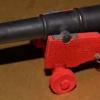

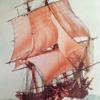
.thumb.jpeg.fc5d633a7b34428fcf19419a73d56d55.jpeg)
